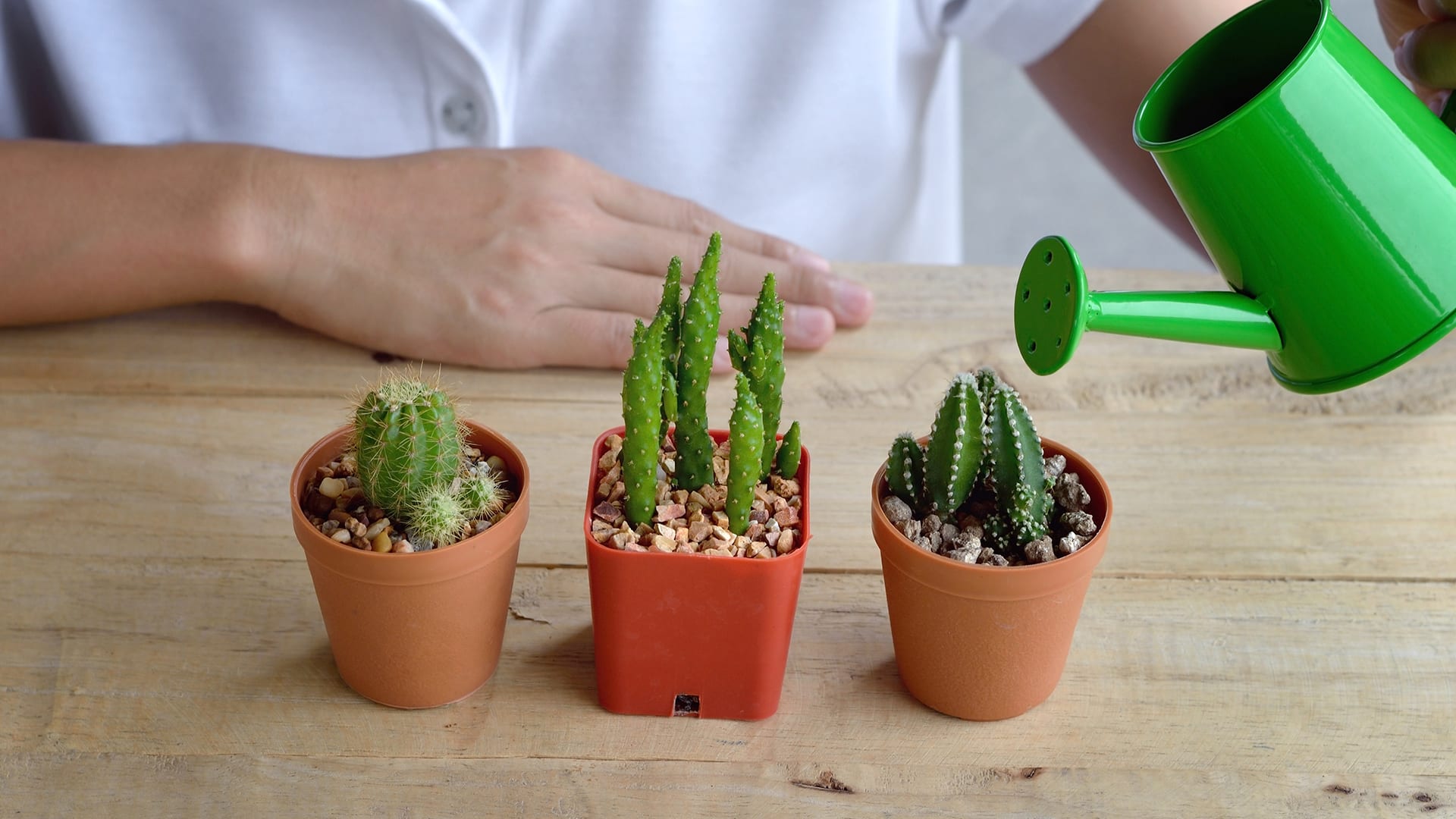Scroll for prep

Please wait…
This video is having trouble loading. You may have lost your Internet connection.
Step 1: Click to Reload this page
Step 2: Click to
Try our other video player
Step 3: contact support if trouble persists.
Or,
dismiss this message.
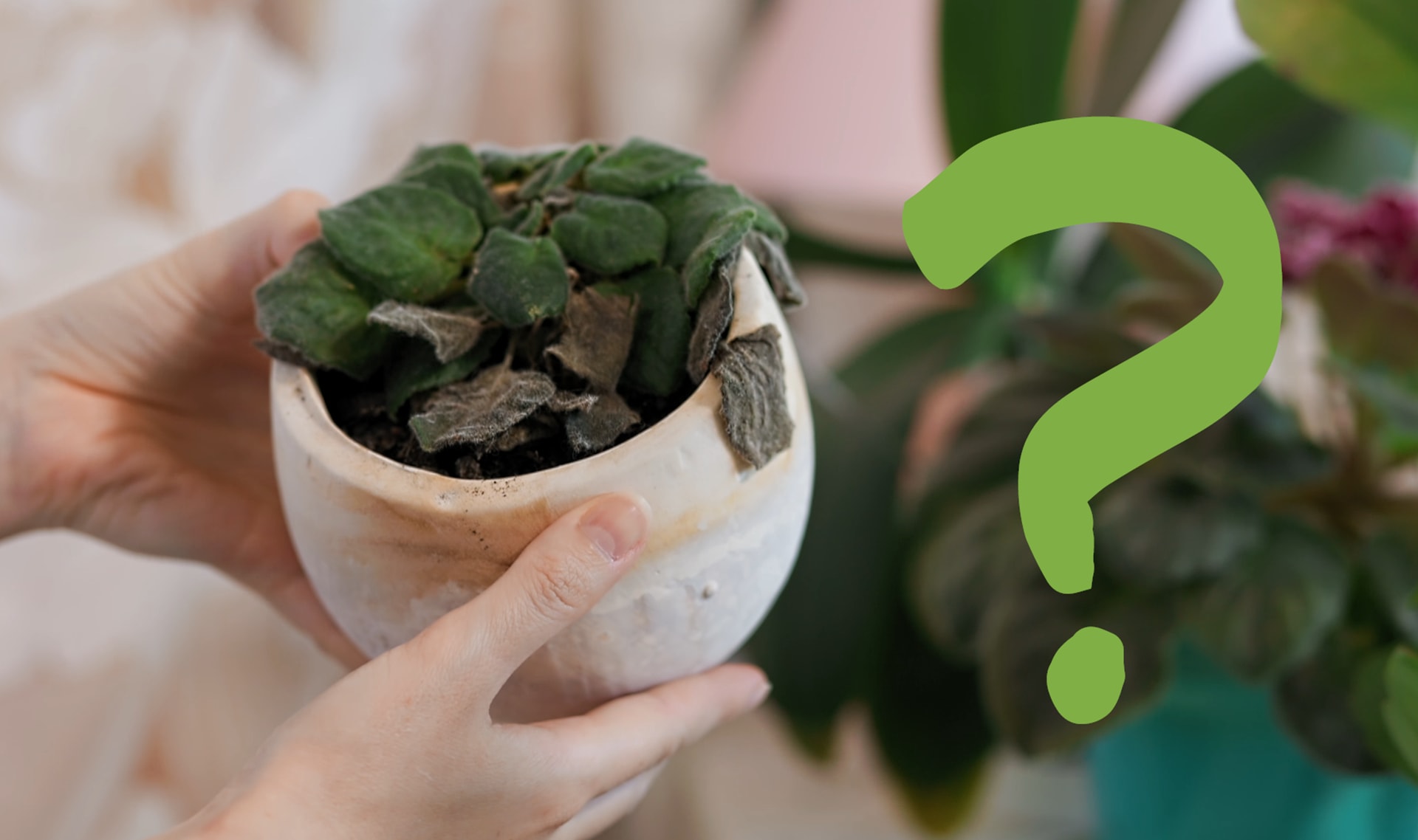
DISCUSS:
Why do you think this plant wilted?
Can you think of anything I could have done differently to keep the plant healthy?
Why do you think this plant wilted?
Can you think of anything I could have done differently to keep the plant healthy?

Please wait…
This video is having trouble loading. You may have lost your Internet connection.
Step 1: Click to Reload this page
Step 2: Click to
Try our other video player
Step 3: contact support if trouble persists.
Or,
dismiss this message.

DISCUSS:
What’s DIFFERENT about these two places?
What’s DIFFERENT about these two places?

Please wait…
This video is having trouble loading. You may have lost your Internet connection.
Step 1: Click to Reload this page
Step 2: Click to
Try our other video player
Step 3: contact support if trouble persists.
Or,
dismiss this message.
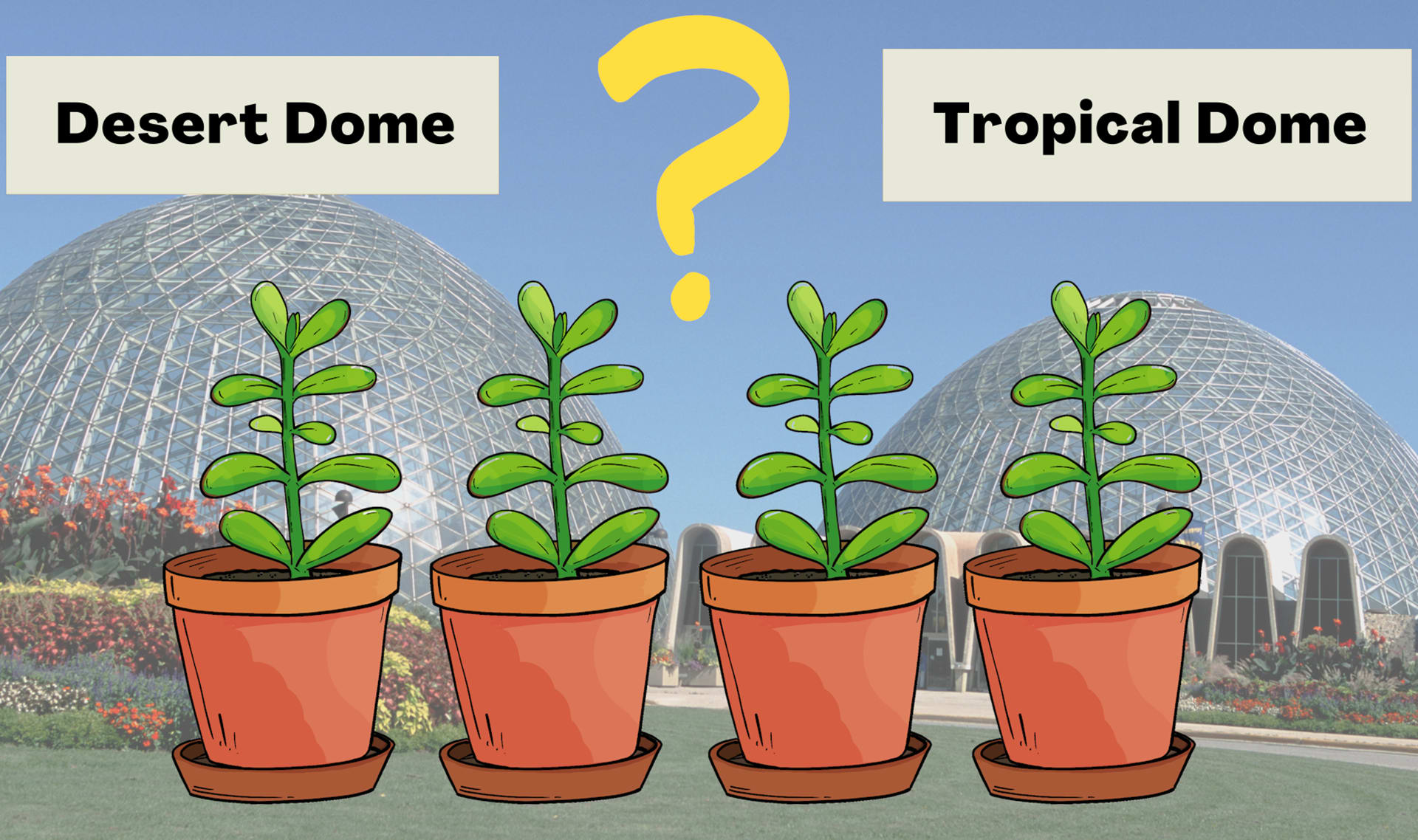
DISCUSS:
How could you figure out whether these mystery plants would grow better in the
Desert Dome or in the Tropical Dome?
How could you figure out whether these mystery plants would grow better in the
Desert Dome or in the Tropical Dome?

Please wait…
This video is having trouble loading. You may have lost your Internet connection.
Step 1: Click to Reload this page
Step 2: Click to
Try our other video player
Step 3: contact support if trouble persists.
Or,
dismiss this message.

Please wait…
This video is having trouble loading. You may have lost your Internet connection.
Step 1: Click to Reload this page
Step 2: Click to
Try our other video player
Step 3: contact support if trouble persists.
Or,
dismiss this message.
Step
01/18
01/18
You’ll work with a partner.

Please wait…
This video is having trouble loading. You may have lost your Internet connection.
Step 1: Click to Reload this page
Step 2: Click to
Try our other video player
Step 3: contact support if trouble persists.
Or,
dismiss this message.
Step
02/18
02/18
Get your supplies.

Please wait…
This video is having trouble loading. You may have lost your Internet connection.
Step 1: Click to Reload this page
Step 2: Click to
Try our other video player
Step 3: contact support if trouble persists.
Or,
dismiss this message.
Step
03/18
03/18
Get your Build-Your-Own Experiment sheet.
First, cut along the thick gray line. Then, cut along all the dotted lines.
Separate the pieces into 3 piles.
First, cut along the thick gray line. Then, cut along all the dotted lines.
Separate the pieces into 3 piles.

Please wait…
This video is having trouble loading. You may have lost your Internet connection.
Step 1: Click to Reload this page
Step 2: Click to
Try our other video player
Step 3: contact support if trouble persists.
Or,
dismiss this message.
Step
04/18
04/18
Get your Water Experiment worksheet and two Mystery Plant
pieces. Turn the pieces over. Lay them on the scrap paper. Add glue.
Then, place one Mystery Plant in Box A and the other in Box B.
pieces. Turn the pieces over. Lay them on the scrap paper. Add glue.
Then, place one Mystery Plant in Box A and the other in Box B.

Please wait…
This video is having trouble loading. You may have lost your Internet connection.
Step 1: Click to Reload this page
Step 2: Click to
Try our other video player
Step 3: contact support if trouble persists.
Or,
dismiss this message.
Step
05a/18
05a/18
Water Experiment. We want to figure out how much WATER the
Mystery Plants need to stay healthy. So, which idea do you think
would help us figure it out? Why do you think that?
Mystery Plants need to stay healthy. So, which idea do you think
would help us figure it out? Why do you think that?

Please wait…
This video is having trouble loading. You may have lost your Internet connection.
Step 1: Click to Reload this page
Step 2: Click to
Try our other video player
Step 3: contact support if trouble persists.
Or,
dismiss this message.
Step
05b/18
05b/18
Here’s what we noticed.

Please wait…
This video is having trouble loading. You may have lost your Internet connection.
Step 1: Click to Reload this page
Step 2: Click to
Try our other video player
Step 3: contact support if trouble persists.
Or,
dismiss this message.
Step
06/18
06/18
Get two Sun pieces, add glue, and place one in box A and one in box B
on your Water Experiment worksheet. Add color using crayons.
on your Water Experiment worksheet. Add color using crayons.

Please wait…
This video is having trouble loading. You may have lost your Internet connection.
Step 1: Click to Reload this page
Step 2: Click to
Try our other video player
Step 3: contact support if trouble persists.
Or,
dismiss this message.
Step
07/18
07/18
Get two water container pieces, add glue, and place them on your
experiment worksheet. Then, use your blue crayon to color in the
different amounts of water that will be given to each plant.
experiment worksheet. Then, use your blue crayon to color in the
different amounts of water that will be given to each plant.

Please wait…
This video is having trouble loading. You may have lost your Internet connection.
Step 1: Click to Reload this page
Step 2: Click to
Try our other video player
Step 3: contact support if trouble persists.
Or,
dismiss this message.
Step
08/18
08/18
Bianca gave the plant in Box A lots of water. She gave the plant in
Box B just a little water. Here’s what the plants looked like after the
end of the experiment. Discuss:
Box B just a little water. Here’s what the plants looked like after the
end of the experiment. Discuss:

Please wait…
This video is having trouble loading. You may have lost your Internet connection.
Step 1: Click to Reload this page
Step 2: Click to
Try our other video player
Step 3: contact support if trouble persists.
Or,
dismiss this message.
Step
09/18
09/18
Here’s what we noticed.
Draw the new leaves and color your plants with crayon to show what
the Mystery Plants looked like after the Water Experiment.
Draw the new leaves and color your plants with crayon to show what
the Mystery Plants looked like after the Water Experiment.

Please wait…
This video is having trouble loading. You may have lost your Internet connection.
Step 1: Click to Reload this page
Step 2: Click to
Try our other video player
Step 3: contact support if trouble persists.
Or,
dismiss this message.
Step
10/18
10/18
Discuss.
Then, circle the answer on your Water Experiment worksheet.
Then, circle the answer on your Water Experiment worksheet.

Please wait…
This video is having trouble loading. You may have lost your Internet connection.
Step 1: Click to Reload this page
Step 2: Click to
Try our other video player
Step 3: contact support if trouble persists.
Or,
dismiss this message.
Step
11/18
11/18
Get your Sunlight Experiment worksheet and two Mystery Plant
pieces. Turn the pieces over and add glue to the back.
Then, place one Mystery Plant in Box A and the other in Box B.
pieces. Turn the pieces over and add glue to the back.
Then, place one Mystery Plant in Box A and the other in Box B.

Please wait…
This video is having trouble loading. You may have lost your Internet connection.
Step 1: Click to Reload this page
Step 2: Click to
Try our other video player
Step 3: contact support if trouble persists.
Or,
dismiss this message.
Step
12a/18
12a/18
Sunlight Experiment. Which idea do you think would work best to
find out how much SUNLIGHT the Mystery Plants need to stay
healthy? Why do you think that?
find out how much SUNLIGHT the Mystery Plants need to stay
healthy? Why do you think that?

Please wait…
This video is having trouble loading. You may have lost your Internet connection.
Step 1: Click to Reload this page
Step 2: Click to
Try our other video player
Step 3: contact support if trouble persists.
Or,
dismiss this message.
Step
12b/18
12b/18
Here’s what we noticed.

Please wait…
This video is having trouble loading. You may have lost your Internet connection.
Step 1: Click to Reload this page
Step 2: Click to
Try our other video player
Step 3: contact support if trouble persists.
Or,
dismiss this message.
Step
13/18
13/18
Find two water container pieces. Turn them over and add glue to the
back. Then, place one in Box A and the other in Box B. Use your
crayon to color in the amount of water that you’ll give to each plant.
back. Then, place one in Box A and the other in Box B. Use your
crayon to color in the amount of water that you’ll give to each plant.

Please wait…
This video is having trouble loading. You may have lost your Internet connection.
Step 1: Click to Reload this page
Step 2: Click to
Try our other video player
Step 3: contact support if trouble persists.
Or,
dismiss this message.
Step
14/18
14/18
Find two Sun pieces. Turn them over and add glue to the back.
Then, place one in Box A and the other in Box B.
Add shade to Box B.
Then, place one in Box A and the other in Box B.
Add shade to Box B.

Please wait…
This video is having trouble loading. You may have lost your Internet connection.
Step 1: Click to Reload this page
Step 2: Click to
Try our other video player
Step 3: contact support if trouble persists.
Or,
dismiss this message.
Step
15/18
15/18
Here’s what Ahmed observed after running his experiment for
several weeks.
Discuss:
several weeks.
Discuss:

Please wait…
This video is having trouble loading. You may have lost your Internet connection.
Step 1: Click to Reload this page
Step 2: Click to
Try our other video player
Step 3: contact support if trouble persists.
Or,
dismiss this message.
Step
16/18
16/18
Here’s what we noticed.
Draw the new leaves and color your plants with crayon to show what
the Mystery Plants looked like after the Sunlight Experiment.
Draw the new leaves and color your plants with crayon to show what
the Mystery Plants looked like after the Sunlight Experiment.

Please wait…
This video is having trouble loading. You may have lost your Internet connection.
Step 1: Click to Reload this page
Step 2: Click to
Try our other video player
Step 3: contact support if trouble persists.
Or,
dismiss this message.
Step
17/18
17/18
Discuss.
Then, circle the answer on your Sunlight Experiment worksheet.
Then, circle the answer on your Sunlight Experiment worksheet.

Please wait…
This video is having trouble loading. You may have lost your Internet connection.
Step 1: Click to Reload this page
Step 2: Click to
Try our other video player
Step 3: contact support if trouble persists.
Or,
dismiss this message.
Step
18/18
18/18
Discuss.

Please wait…
This video is having trouble loading. You may have lost your Internet connection.
Step 1: Click to Reload this page
Step 2: Click to
Try our other video player
Step 3: contact support if trouble persists.
Or,
dismiss this message.
DISCUSS:
Imagine you tried to set up these experiments in REAL LIFE.
Can you think of any new challenges you might face if you tried these experiments in the real world?

Please wait…
This video is having trouble loading. You may have lost your Internet connection.
Step 1: Click to Reload this page
Step 2: Click to
Try our other video player
Step 3: contact support if trouble persists.
Or,
dismiss this message.
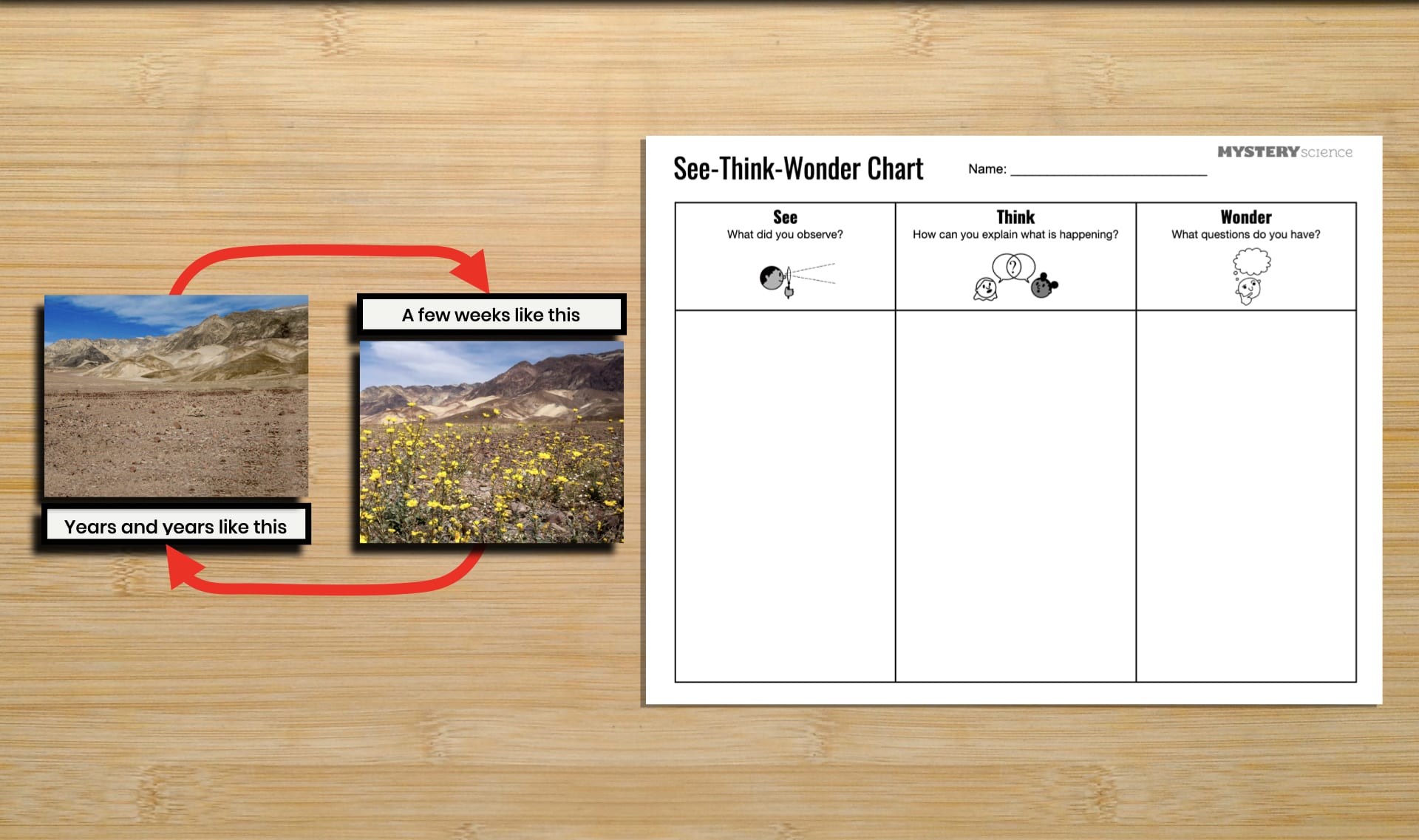
Anchor Connection
Discuss. Look at the "Wonder" column of your class See-Think-Wonder chart.
Have any questions been answered by the past lesson?

Step
01/13
01/13
In the past lesson, you saw plants like this in the desert dome.
Discuss. Do these plants need a little water, or a lot? And do
these plants need shade, or bright sunlight?

Step
02/13
02/13
Different plants need different amounts of light and water. Most
plants in the desert need lots of sunlight, but very little water.
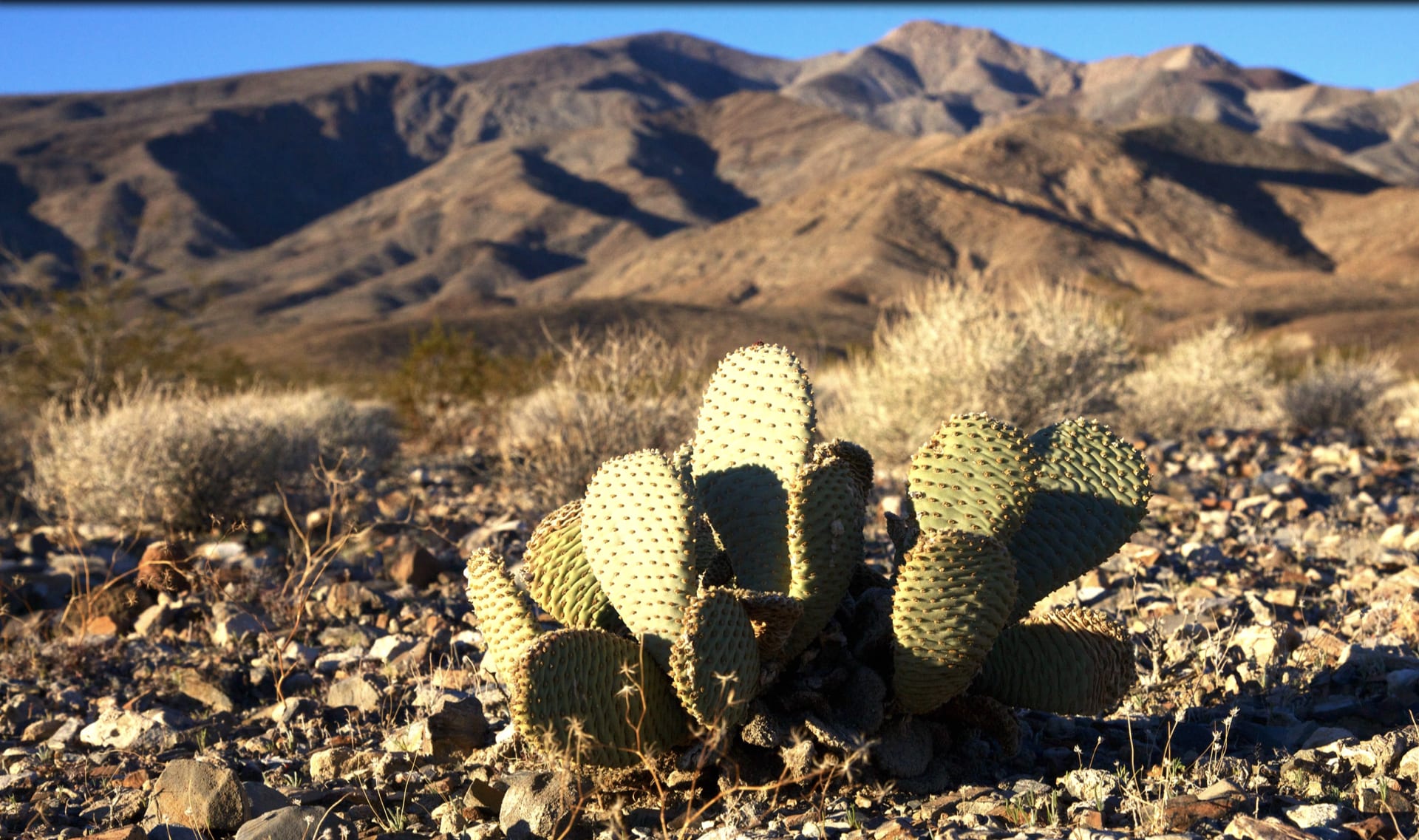
Step
03/13
03/13
A cactus can grow well in Death Valley because it is very, very dry
here. This cactus gets just the right amount of water.

Step
04/13
04/13
A cactus needs very little water, but a lot of light.
That makes Death Valley a good place for a cactus!
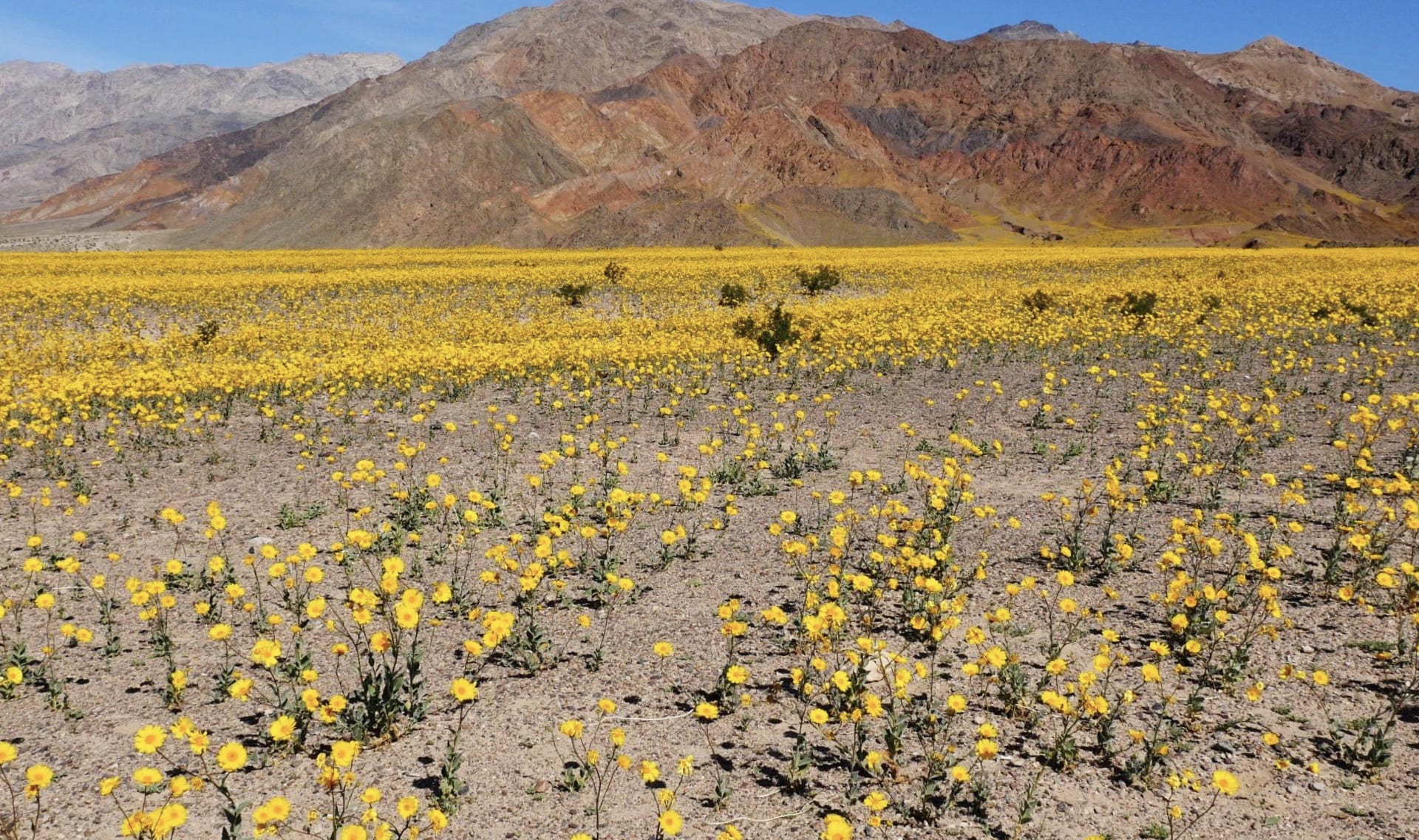
Step
05/13
05/13
Death Valley is not always a good place for the superbloom flowers.
These flowers need the right amount of light and water, but Death
Valley usually has too much of one and not enough of the other.
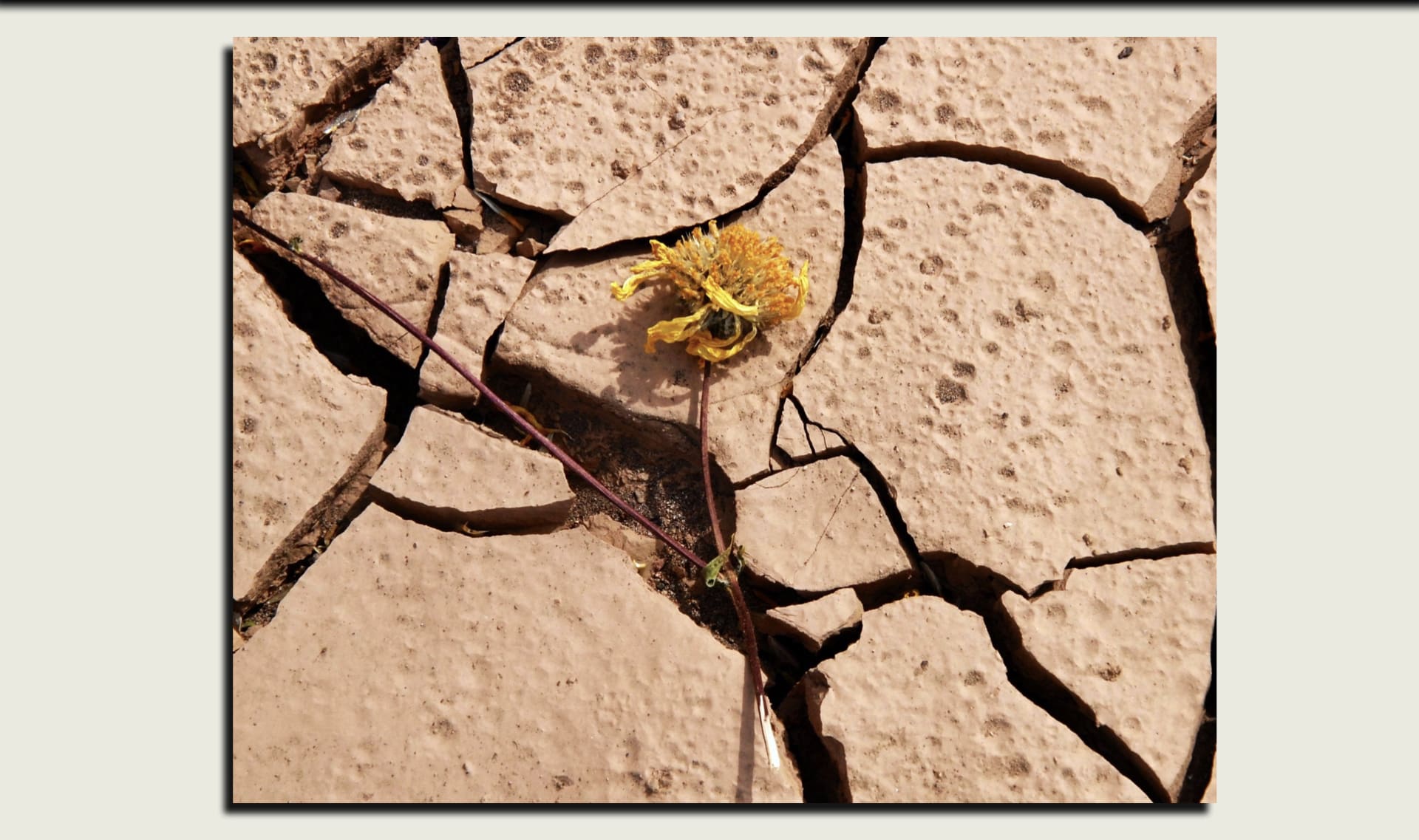
Step
06/13
06/13
A few weeks after the flowers bloom, they dry up, like this.
Discuss. Why do you think the flowers dry up in Death
Valley? (Hint: think about the right amounts of water and light.)
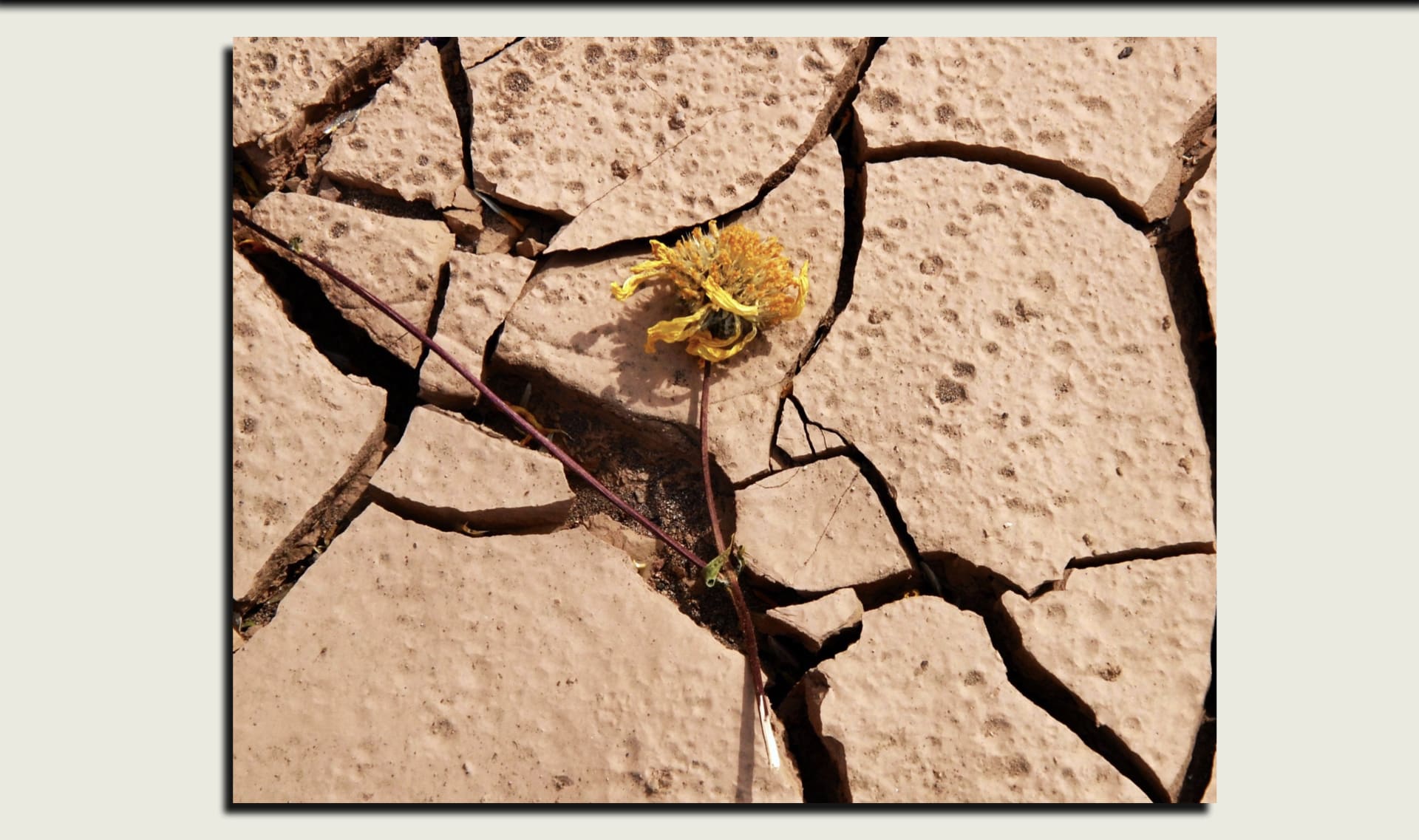
Step
07/13
07/13
Death Valley has too much light for the flowers. All of the light makes
it very hot. And there is too little water for the flowers. Too much
light and heat and too little water are just wrong for the flowers.
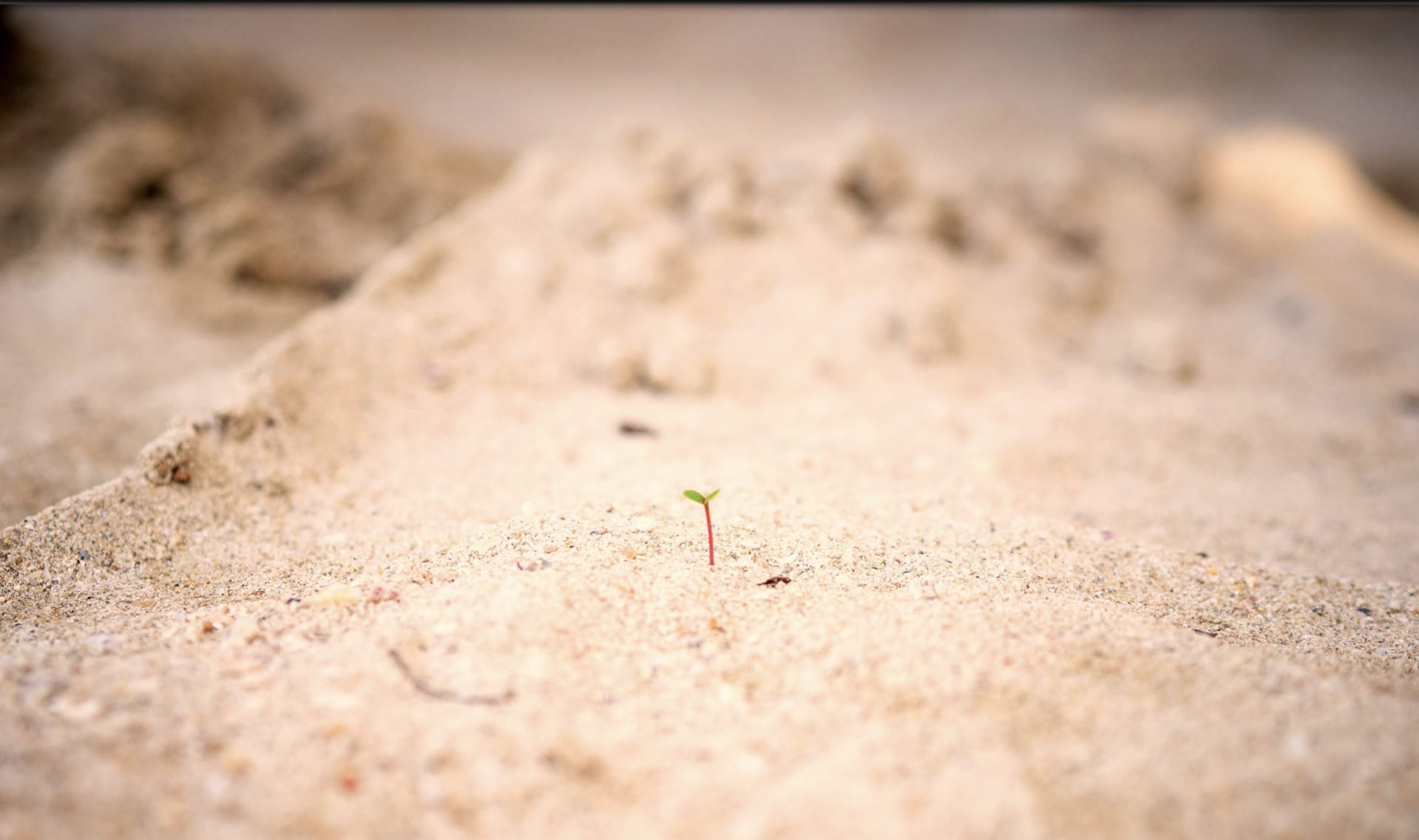
Step
08/13
08/13
But seeds are waiting in the sand. The superbloom cycle will happen
again the next time the water, light, and warmth are just right!
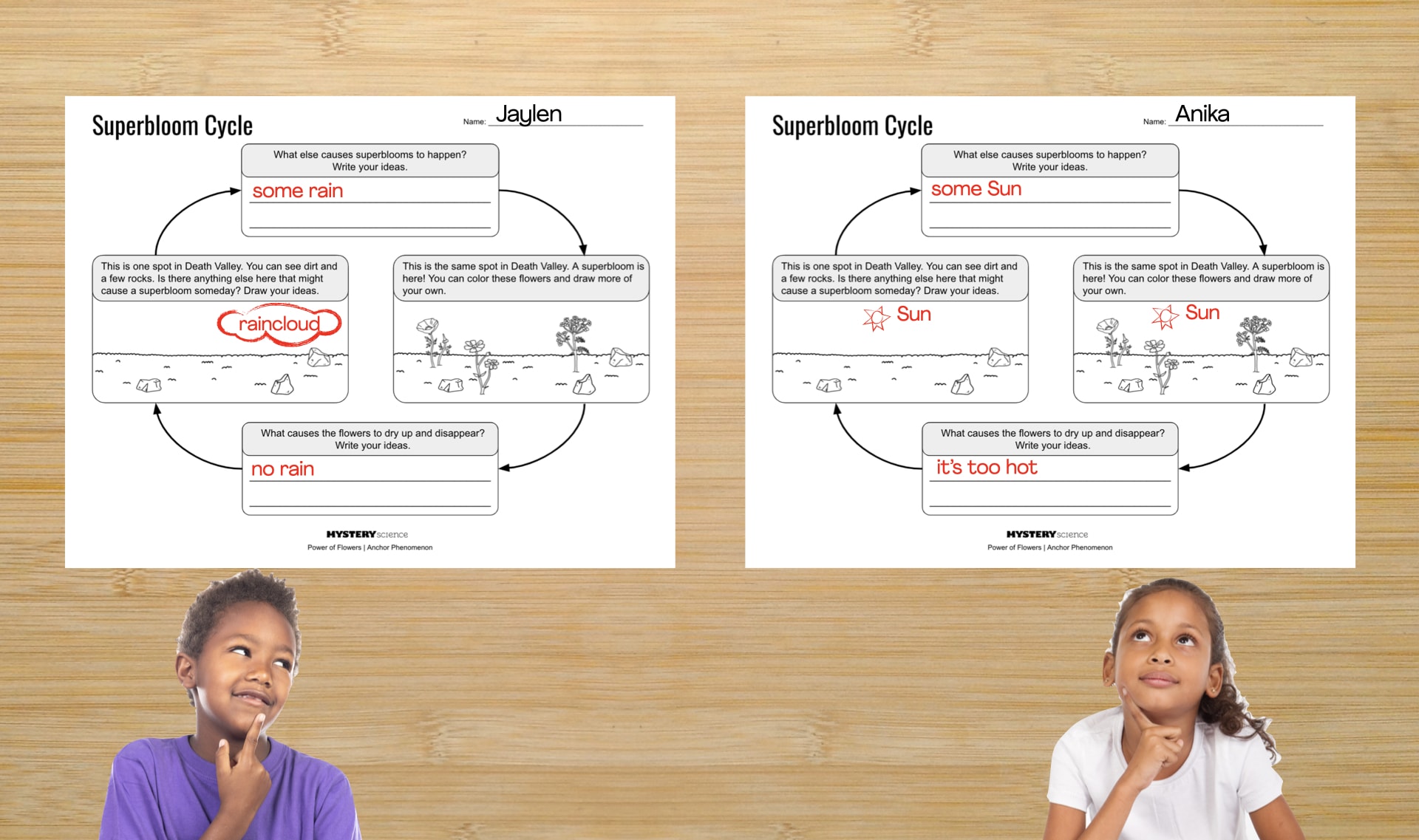
Step
09/13
09/13
Discuss. We know that not enough water and too much light and
heat make superbloom flowers dry up and disappear. What should
these students add to their sheets? How should they do it?
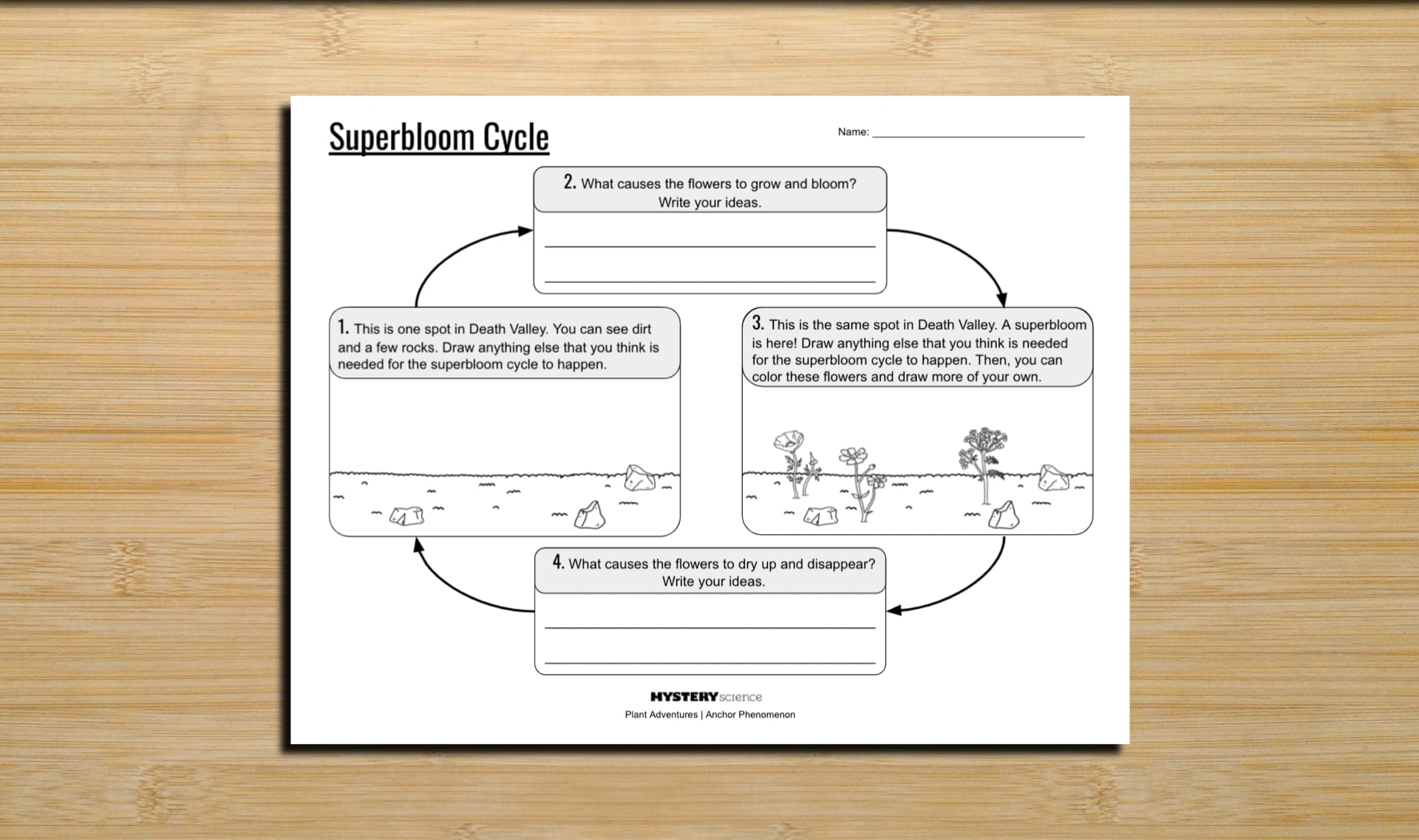
Step
10/13
10/13
Get your Superbloom Cycle worksheet.
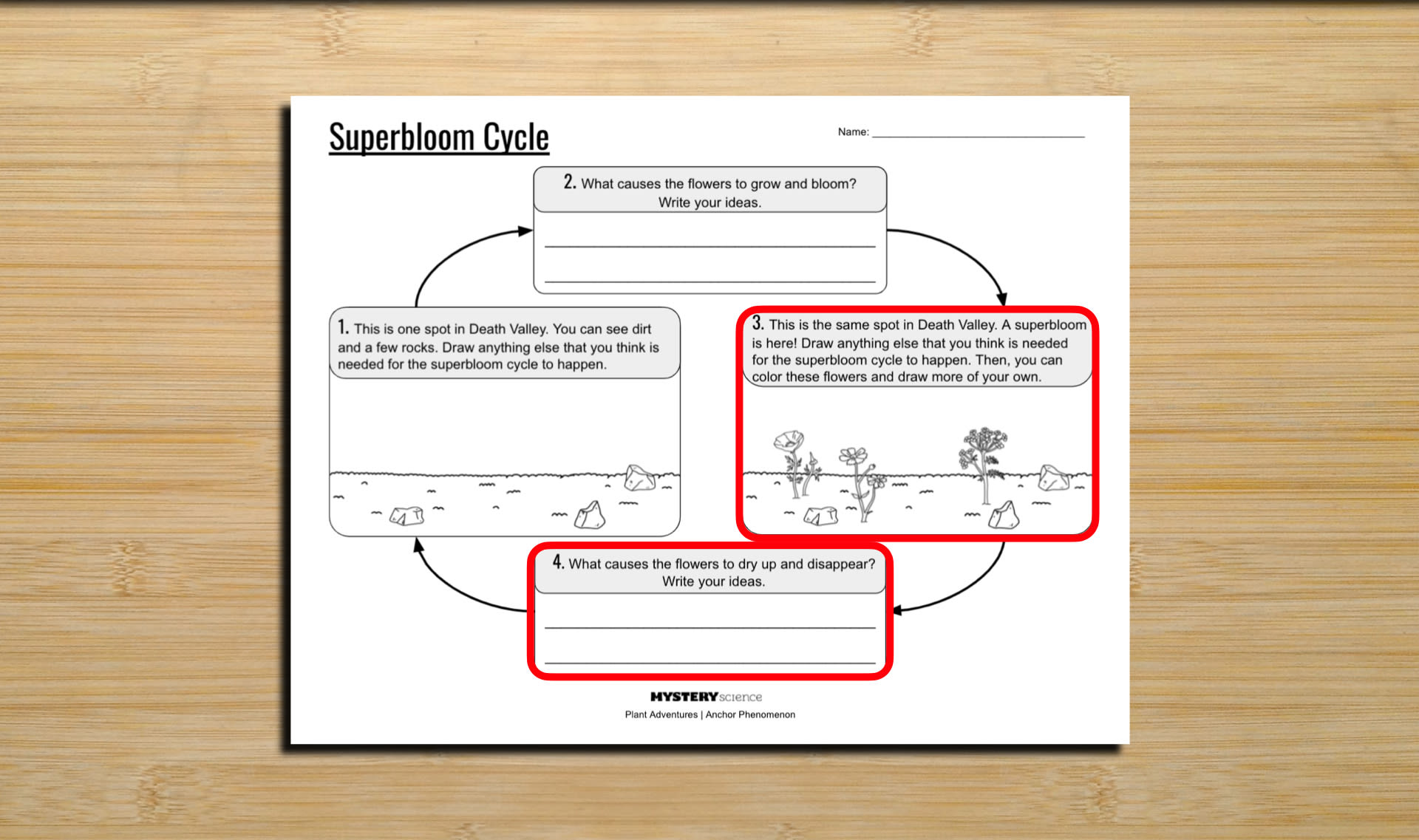
Step
11/13
11/13
If you didn’t write or draw about light and heat yet, do so now. You
can write words or draw pictures.

Step
12/13
12/13
If you didn’t write or draw about there not being enough water, do
so now. You can write words or draw pictures.
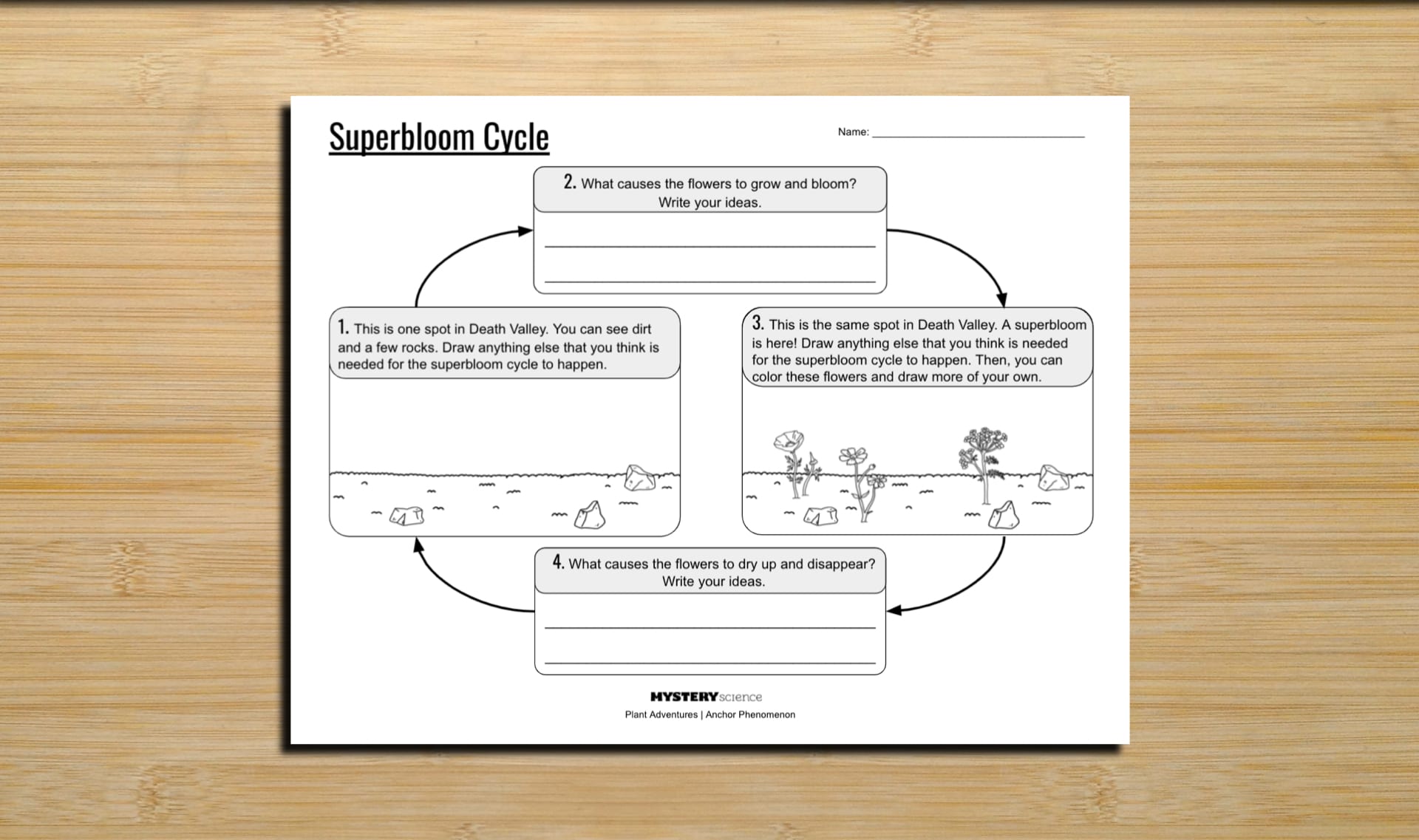
Step
13/13
13/13
This is the last update you will make to the Superbloom Cycle
worksheet! Discuss. What changes did you make to your sheet as
you learned new things?

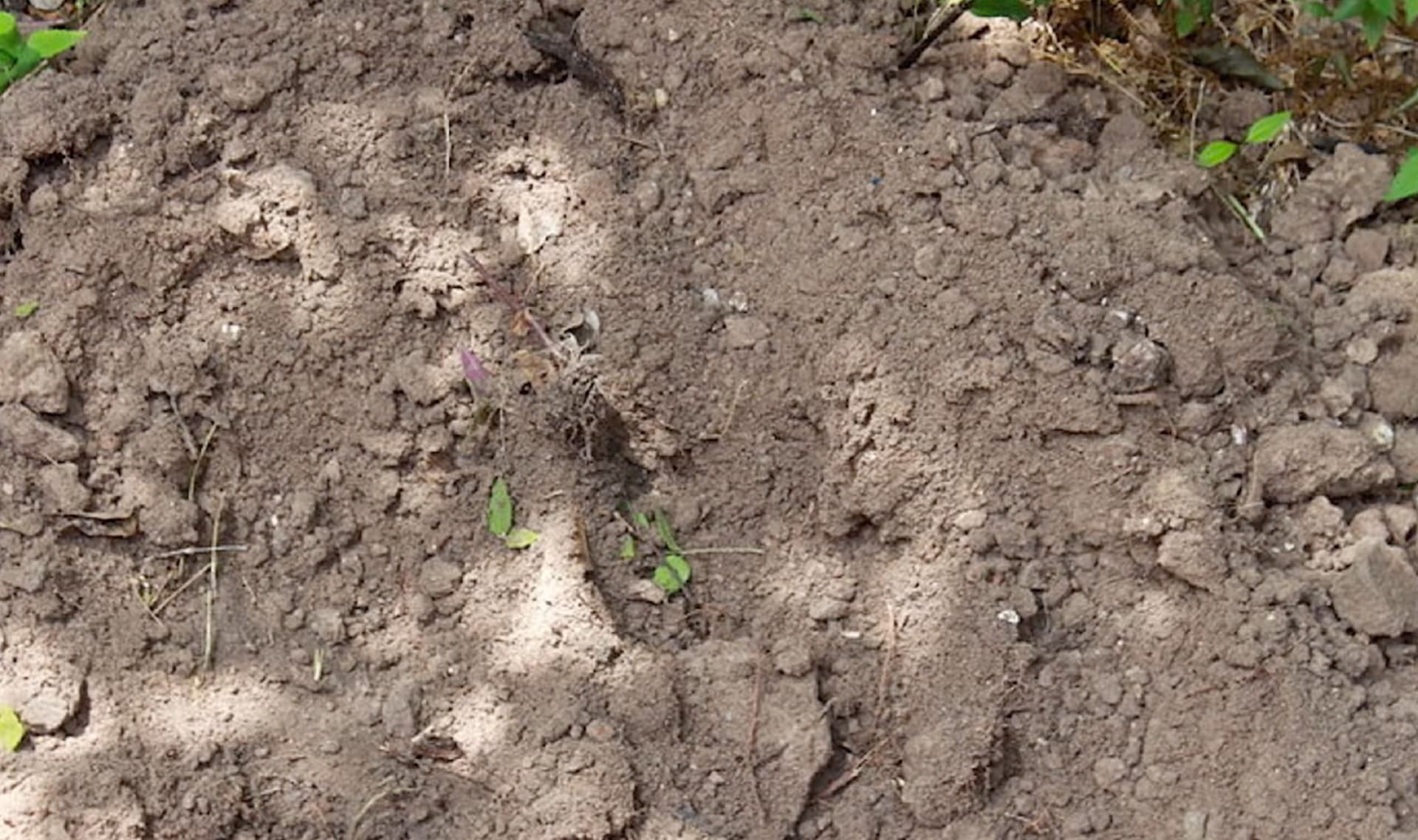
soil
1 of 8
tiny pieces of rock and other materials that cover the ground

sunlight
2 of 8
light from the Sun
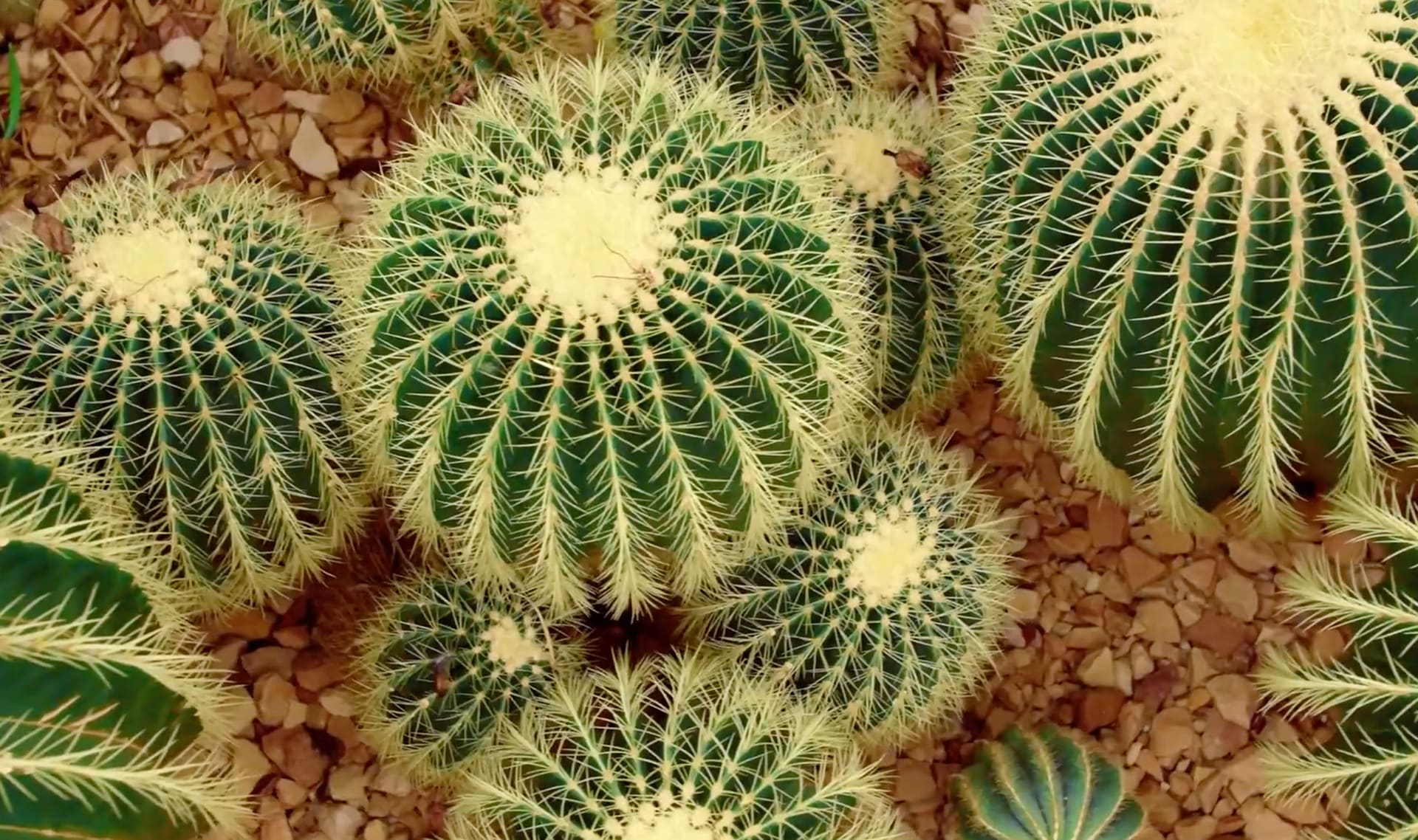
cactus
3 of 8
a type of plant that usually has spikes and is found in the desert
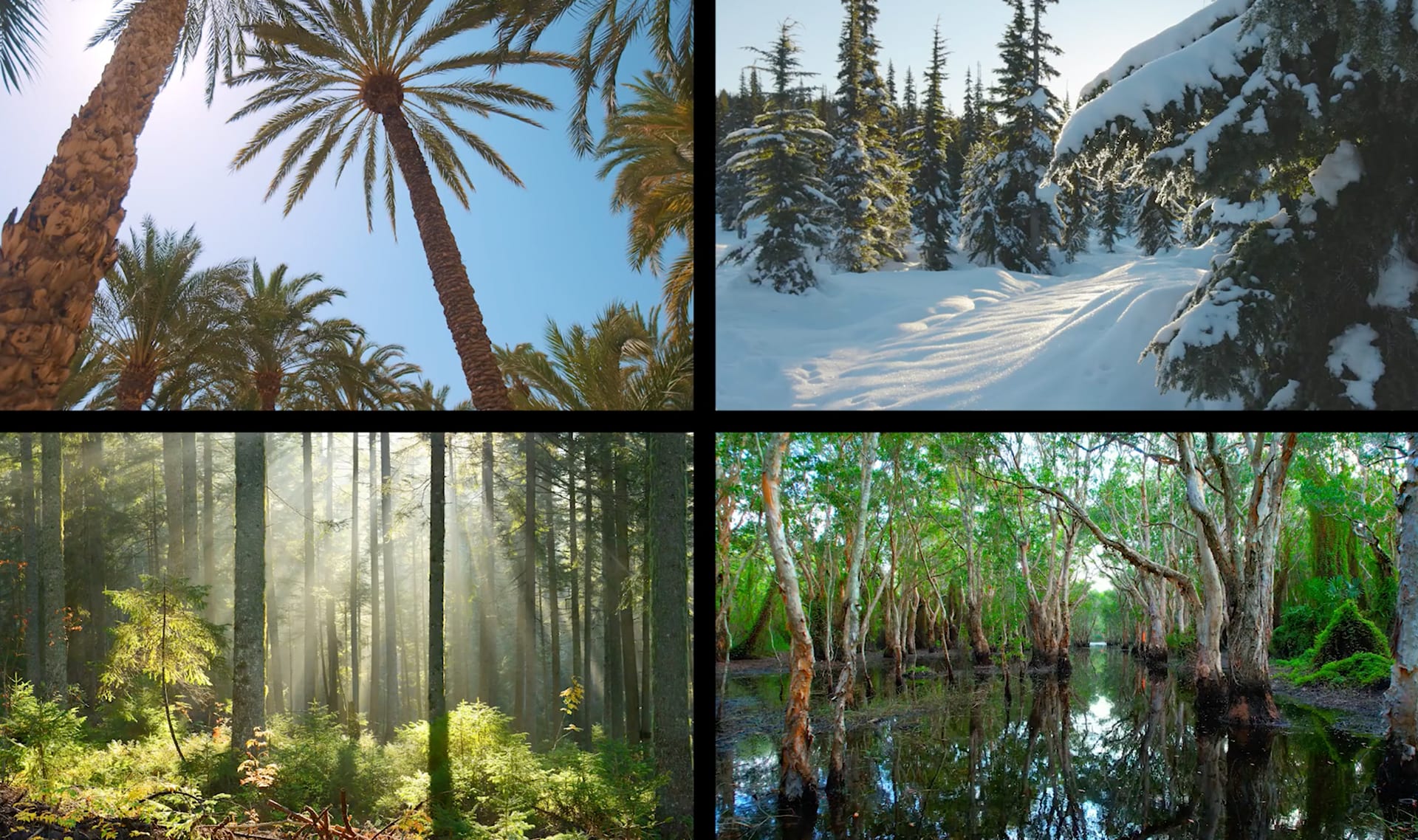
habitat
4 of 8
the place where an animal or plant lives
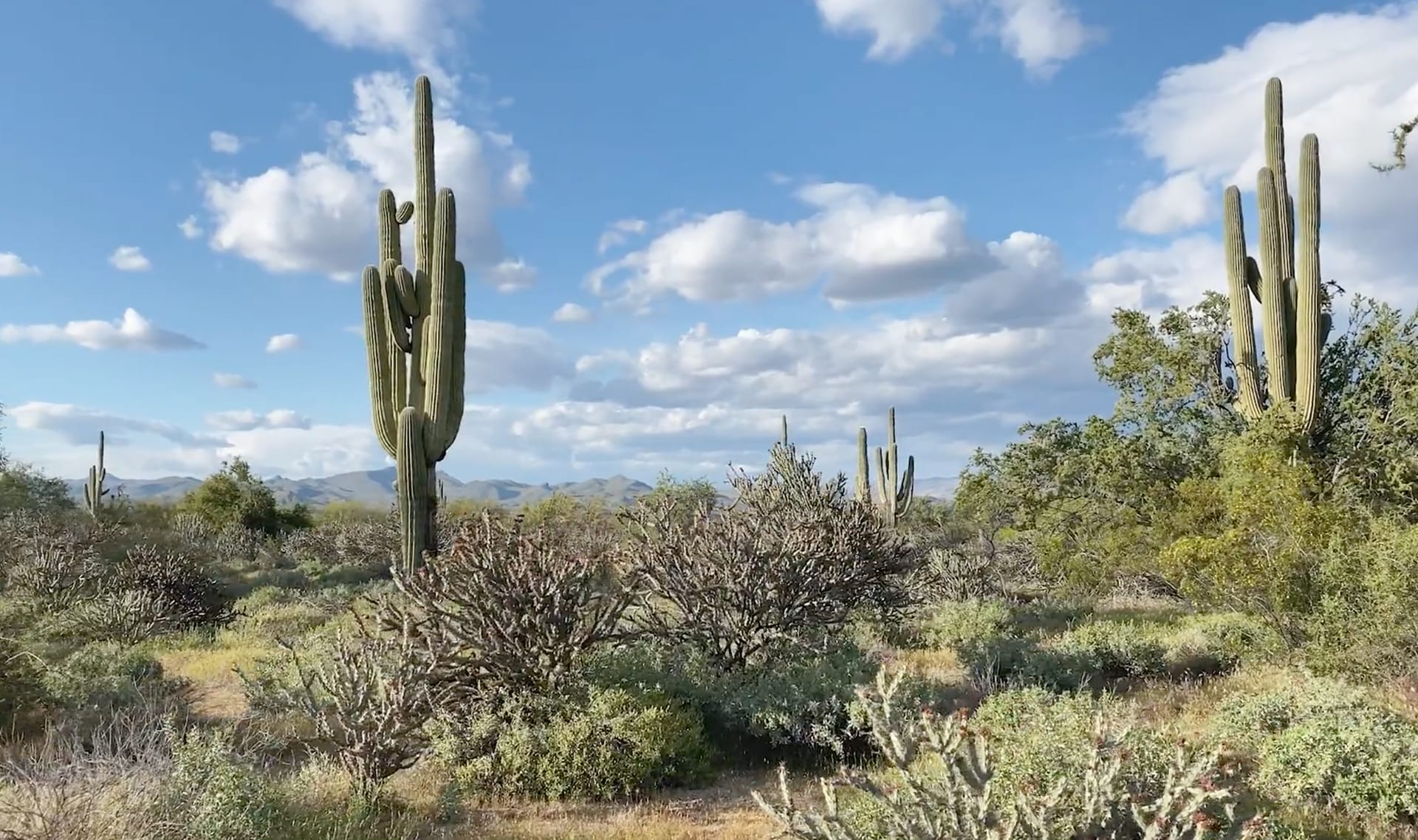
desert
5 of 8
a habitat that is usually hot and that gets very little rain
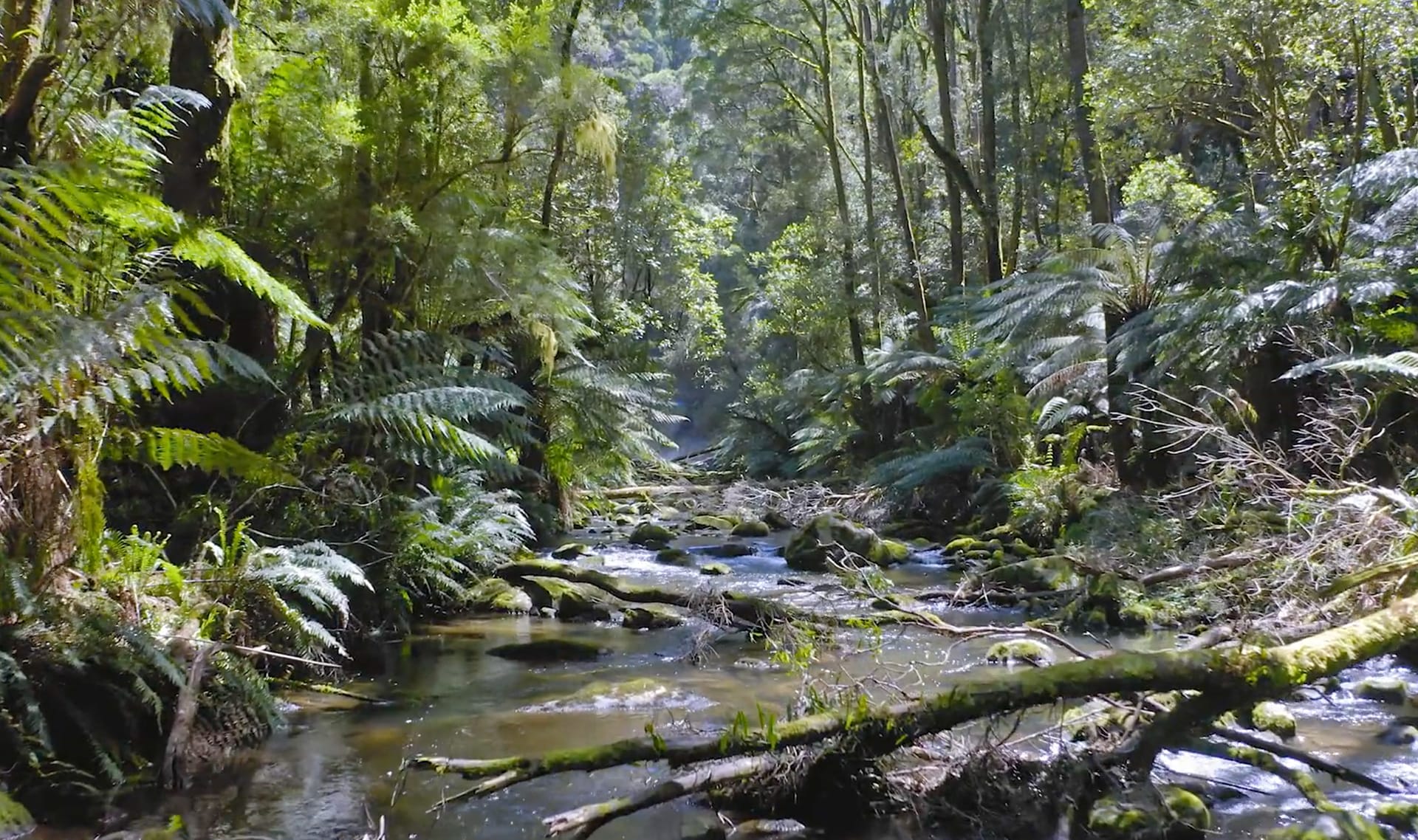
rainforest
6 of 8
a habitat that is usually warm and gets lots of rain
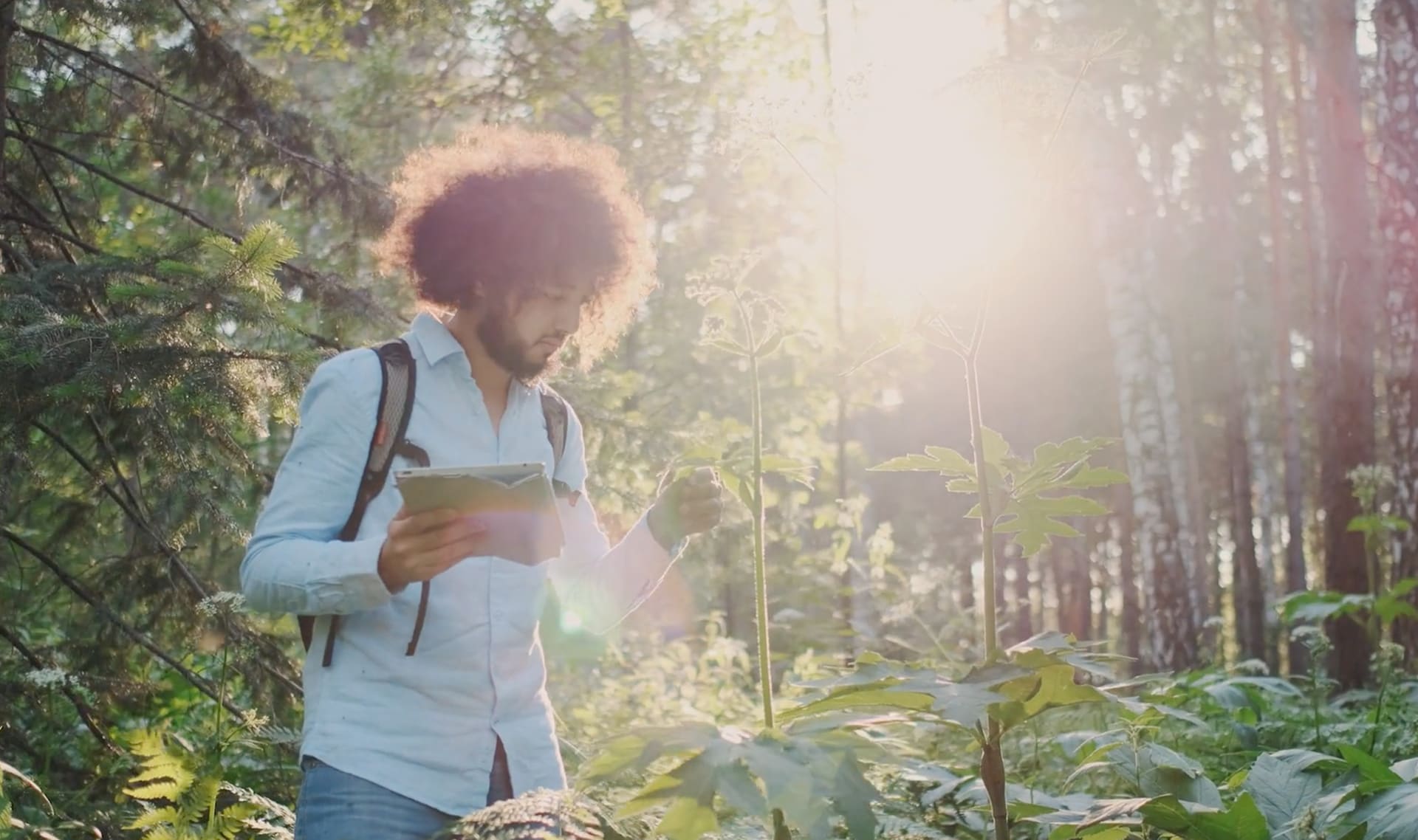
investigate
7 of 8
to figure out the answer to a question or to understand how something works
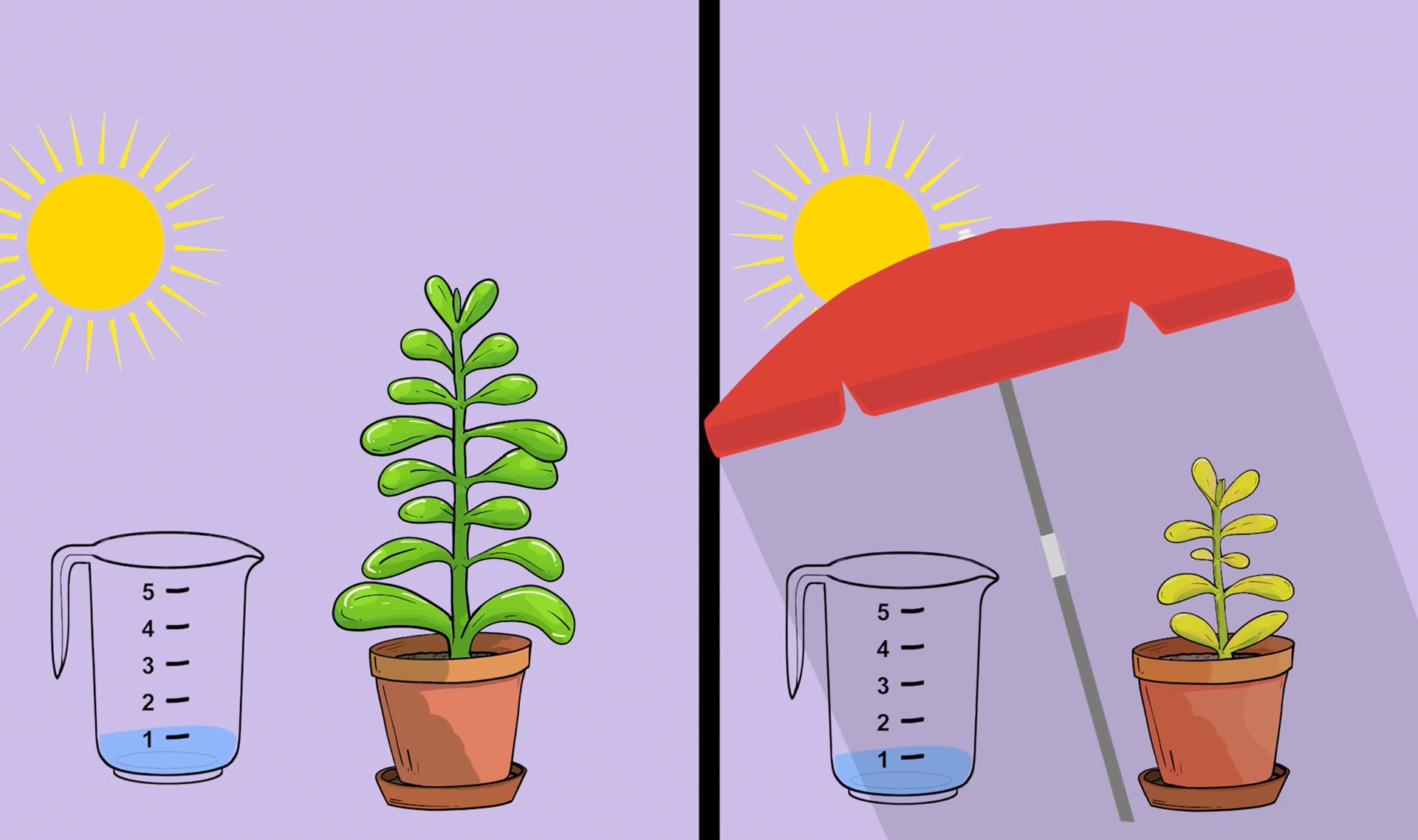
experiment
8 of 8
a test used to discover new information about a question
🎉
That’s it for this lesson! How did it go?
Extend this lesson
Sign up now for more great lessons!
